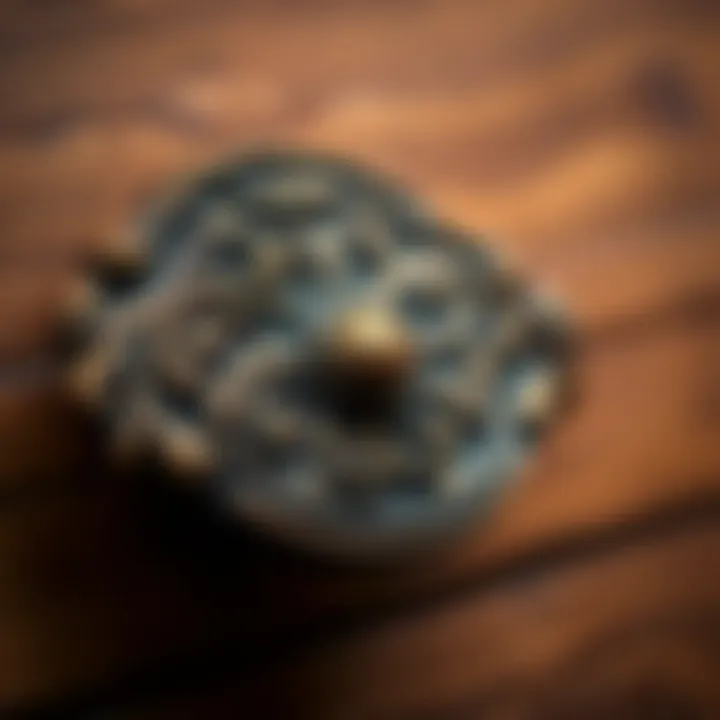Antique Single Hole Drawer Pulls: History and Design


Intro
Antique single hole drawer pulls may seem like a small detail in the grand scheme of interior design, but they play a surprisingly significant role in both aesthetic appeal and function. These pieces of hardware not only reflect a bygone era of craftsmanship but also hold stories of their own. As simple as they appear, a well-crafted single hole drawer pull can transform mundane furniture into standout pieces, adding character to contemporary interiors.
In this exploration, we'll journey through the historical significance of these pulls, examining the intricacies of their design and craftsmanship. Whether you're an avid collector, a fashion-forward designer, or simply someone with a keen eye for detail, understanding the values these antique pulls convey—and how they harmonize with modern decor—can provide insights into effective restoration techniques and the current market landscape.
It’s essential to delve into the materials used, the evolution of their designs, and their practical applications today. For those in the know, a single hole drawer pull is not merely a functional device; it is a narrative element, an artistic statement that can greatly influence the ambiance of a room. Through this exploration, you’ll gain a well-rounded understanding of antique single hole drawer pulls, learning to appreciate their unique charm and enduring relevance in modern interiors.
Prelims to Antique Single Hole Drawer Pulls
Understanding antique single hole drawer pulls is more than just delving into their aesthetic appeal; it's a study of history, craftsmanship, and the story behind each piece. In this exploration, we aim to uncover the layers that contribute to the significance of these seemingly simple hardware items in our living spaces. By doing so, we illuminate the intersection of artistry and functionality—two elements that define truly great design.
When discussing antique drawer pulls, it’s essential to grasp what makes them antique and how that classification affects their value and applicability in today’s interiors. The term "antique" typically refers to items that are over a hundred years old, steeped in history and craftsmanship that newer pieces often lack. These drawer pulls carry characteristics and mechanics that reflect the era they originate from, often revealing stories of the artisans who crafted them and the societies they served.
Defining Antique Drawer Pulls
Antique drawer pulls are precision-crafted hardware that fit into a single hole in a drawer front, consisting of distinctive designs and materials that vary in taste and preference. They serve not only as a functional component but also as a decorative accent. Most can be categorized based on various historical movements, styles, and materials utilized in their creation.
Historically, these pulls come in many shapes and forms, often reflecting the prevailing styles of the time. For instance, a Victorian pull might showcase ornate details, while a simpler Edwardian knob could lean more toward minimalism. The distinction in these designs is crucial for collectors and designers alike, as these elements greatly influence both value and desirability.
The allure of antique single hole drawer pulls lies in their individuality. Each piece has its own story, marked by wear and tear or unique craftsmanship. You may find a pull crafted from solid brass showing a rich patina that speaks to its age or perhaps one made of wood with delicate engravings that tell of artisanal excellence—each pull acting as a window to the past.
Importance in Interior Design
The role of antique single hole drawer pulls in interior design is more significant than one might assume at first glance. These hardware pieces not only serve as functional tools but also contribute to the overall character and authenticity of a space.
In today’s world, blending vintage antiques with modern design principles is a trend that continues to gain traction. Here’s why:
- Contrast and Balance: A sleek modern cabinet can gain warmth and personality from a classic antique pull. It creates an intriguing contrast that can elevate the entire aesthetic of the piece.
- Timeless Appeal: Antique drawer pulls add a touch of history to contemporary designs. They evoke a sense of nostalgia while complementing various design themes, be it rustic, mid-century modern, or industrial.
- Sustainability: Using vintage hardware is not just a design choice; it promotes sustainable living. Every old pull reused reduces the demand for new production and the resource consumption that entails.
"Antique drawer pulls are small elements of design, yet they can pivot your entire decor from bland to grand, encapsulating a hundred years of history in a single grasp."
In essence, the significance of antique single hole drawer pulls transcends mere function. In the grand tapestry of interior design, they serve as critical threads, tying together the old and the new, the familiar and the extraordinary, making them indispensable in the crafting of distinctive living environments.
Historical Overview
When we take a closer look at antique single hole drawer pulls, understanding their historical significance sheds light on their evolution over time. This exploration helps to illustrate not only their aesthetic value but also their functional attributes in various design contexts. We can see how the changing styles and materials reflect broader social, economic, and cultural shifts, positioning these drawer pulls as more than mere hardware—they become artifacts telling tales from the past.
Origin of Drawer Pulls
The concept of drawer pulls can be traced back to ancient civilizations, where functionality came first. In Europe, drawers began to emerge as storage solutions in the late Middle Ages. Initially, pulls were rudimentary, often merely carved or painted elements added to wooden boxes. However, as craftsmanship evolved, so did the design and materials used.
Evolution Through Eras
Antique drawer pulls have undergone significant transformations as they passed through various architectural and artistic movements. Each era left its mark on the designs, with trends that mirrored society’s values and tastes.
Colonial Influence
Colonial America introduced a functional yet stylish influence on drawer pulls. Made from sturdy materials like wrought iron and later brass, these pulls showcased intricate craftsmanship typical of the time.
The key characteristic of Colonial pulls is their simplicity blended with utility. While focusing on practicality, artisans used locally sourced materials, making each piece unique and often reflecting the natural landscape. This benefit of locally inspired designs provides collectors with an authentic connection to their heritage. A distinctive feature of Colonial pulls can be noted in the use of hand-forged iron, imbuing each piece with a rugged durability.
However, while their sturdiness is an advantage, it also means some of these pulls are heavier, which might not suit every modern application. Still, die-hard enthusiasts appreciate their weighty presence as a testament to craftsmanship.
Victorian Aesthetics
The Victorian era marked a shift toward ornamental design, influencing drawer pulls significantly. The elaborateness and grandeur of Victorian pulls often included lady-like curves and floral patterns. These pulls were not just functional; they were a statement of wealth and taste.
Victorian pulls are characterized by intricate detailing and a wide variety of materials, including brass and glass. This intricate craftsmanship makes them a beloved choice due to their intricate designs and ability to evoke a sense of nostalgia. A unique feature of these pulls is their use of vibrant colors and patterns, often matching the rich textures of Victorian furniture.
On the downside, their ornate nature may not align with the minimalist aesthetic favored in contemporary designs, presenting a challenge for modern adaptations.


Art Deco Designs
The Art Deco movement, emerging in the 1920s, introduced a new level of sophistication and geometric styling to drawer pulls. These designs embodied modernity, often featuring sleek shapes and materials like chrome and Bakelite. The characteristic sharp lines and bright finishes combined to elevate drawer pulls from mere hardware to pieces of art.
Art Deco pulls are celebrated for their unique aesthetic appeal and playfulness, providing an energetic focus for furniture design. The advantage lies in their capability to stand out or seamlessly fit into a more modern decor scheme, making them versatile in today’s interiors.
However, the rise of synthetic materials in this era also means some finds may not possess the same longevity as their older counterparts. Collectors must be discerning, balancing aesthetics with durability when considering these pulls.
In sum, the historical journey of drawer pulls is rich with intricate details and cultural significance, offering insight not only into design evolution but also into the societal values of different eras. Understanding this context heightens the appreciation for each piece, making antique single hole drawer pulls more than a functional necessity—they become a pathway to history.
Materials Used in Production
The materials utilized in crafting antique single hole drawer pulls play a pivotal role in defining their aesthetics and functionality. Understanding the various substances involved in their production not only enhances appreciation for these pieces but also guides collectors and designers in making informed choices. The selection of materials influences durability, appearance, and even the historic value of each item, shaping how they fit into contemporary design narratives.
Common Materials
Brass and Bronze
Brass and bronze are staples in the realm of antique drawer pulls. Known for their resilience and striking appearance, these materials offer a timeless elegance. One of the key characteristics of brass is its golden hue, which can cast a warm glow in any interior. Bronze, on the other hand, tends to have a darker, more muted finish that brings a sense of antiquity and weight.
These metals are not just pretty faces; they also resist corrosion, making them practical choices for functional hardware that stands the test of time. However, maintenance is key; although they can patina beautifully, this process can sometimes attract dirt and lead to tarnishing.
Wood and Ceramics
Wood and ceramics whisper tales of warmth and craftsmanship. Wooden drawer pulls evoke a sense of nostalgia and authenticity, often carrying the distinct grains and strokes left by artisan hands. A popular choice, especially in country homes, they introduce a rustic charm to any setting. On the flip side, if not treated well, wooden pulls may warp or crack over time due to humidity changes.
Ceramics, while less common, offer a unique aesthetic. Their capacity for intricate designs and vibrant colors allows for personalization that other materials might lack. They can stand out as focal points, but as a rule, they are typically more fragile, requiring gentle handling.
Glass and Crystal
Glass and crystal pulls bring a sparkle that is hard to resist. Their translucent nature combined with light effects can elevate a drawer pull from mere functionality to striking scenery in a room. Antique crystal pulls, especially, can shimmer like jewels, providing an opulent touch. However, despite their allure, they can be delicate; therefore, selecting quality glass or crystal is essential to ensure longevity.
The desire for glamour often drives the preference for glass pulls in richer home designs, yet they can demand a mindful selection of aesthetic compatibility with the surrounding decor.
Influence of Material on Design
The choice of material can significantly alter the design of antique drawer pulls. For instance, brass often complements modern designs with geometric patterns, while wooden pulls may suit more traditional themes with their organic shapes. Each material's attributes not only dictate the visual appeal but also the tactile experience.
Moreover, the finish applied to these materials, ranging from sleek and polished to matte and antiquated, can further enhance their design characteristics. Knowing how different materials and finishes interact helps in creating harmonious, captivating interiors.
The right material for drawer pulls can transform a simple piece of furniture into a stunning statement in design.
In summation, materials are more than just elements of production; they serve as the backbone of each drawer pull's identity. Their unique properties contribute to the overarching narrative of the piece, melding history with contemporary artistry.
Design Characteristics
The design characteristics of antique single hole drawer pulls are critical as they embody the artistic expression and functionality that define these objects. The aesthetic appeal and intrinsic craftsmanship reflect not just their historical significance but also their usability in contemporary settings. Assessing these elements helps potential collectors and designers appreciate the value and beauty these pulls offer.
Styles and Patterns
Each style and pattern contributes uniquely to the visual language of furniture design. When one chooses an antique drawer pull, they are often making a statement, whether it's to evoke nostalgia or to maintain a cohesive theme in the interior space.
Nautical Themes
Nautical themes have a distinctive charm that resonates deeply with coastal aesthetics. Characterized by motifs such as anchors, shells, and ropes, these pulls evoke a sense of maritime adventure, making them an ideal choice for beach houses or homes that celebrate coastal living. The key characteristic of nautical-themed pulls is their intricate designs, often presenting a whimsical and playful charm.
One of the unique features of these designs is their potential to connect the indoors with the essence of the sea, providing a refreshing vibe. Nautical pulls can serve as conversation starters, effortlessly bridging the gap between history and the modern nautical trend. However, a potential drawback is that they may not blend seamlessly with non-coastal themes, necessitating careful consideration in diverse interior designs.
Floral Motifs
Floral motifs breathe life into antique drawer pulls, offering a touch of nature that softens hard edges in design. These patterns embody a sense of elegance and delicacy, making them a popular option for vintage-style interiors. Notably, they can vary widely from intricately detailed blooms to simpler, stylized shapes, appealing to a broad range of tastes.
Floral designs resonate particularly well in both contemporary and traditional settings, allowing for flexibility in decor. The unique advantage of these motifs lies in their capability to add warmth and character to spaces, drawing attention without overwhelming. However, they might not suit all design preferences, as some may find them too conventional in an increasingly minimalist world.
Geometric Shapes


The use of geometric shapes in antique drawer pulls illustrates a bold approach, appealing to those who appreciate clean lines and structured forms. These designs often feature symmetrical patterns, such as squares, circles, and triangles, which can create a striking contrast on traditional wood furniture. The primary characteristic that stands out is the modern flair these pulls can bring, blending vintage and contemporary styles beautifully.
Unique to geometric designs is their ability to provide visual balance, making them a favored choice for sleek and modern interiors. However, one should note that while they are versatile, they may clash with softer styles, requiring discerning placement to ensure harmony in aesthetic expression.
Finish and Patina
The finish and patina of antique drawer pulls are aspects that speak volumes about their age and character. A well-maintained patina can enhance the authenticity of a piece, as it tells the story of its past, showcasing years of wear and the skilled craftsmanship behind it. This aging can include subtle changes in color, texture, and sheen, each adding to the allure of the drawer pull's design.
Antique collectors and enthusiasts often seek pieces with distinct finishes that showcase their quality and heritage. Restoring the finish requires delicate care; finding the balance between preserving history and enhancing appearance is vital. A thoughtful choice in finish can elevate an interior, adding depth to the overall design.
In summary, understanding design characteristics such as styles, patterns, finishes, and patina not only enriches the appreciation of antique drawer pulls but also fosters thoughtful selection and integration into modern interiors.
Functional Aspects of Drawer Pulls
Antique single hole drawer pulls are not merely decorative objects but serve essential functions that influence their appeal in both historical and modern contexts. Their design and utility merge to create a hardware piece that is as practical as it is beautiful. Understanding the functional aspects of these pulls helps enthusiasts appreciate them beyond aesthetics. Not only do they enhance furniture usability, but they also add character to any drawer or cabinet.
Ease of Use
When considering drawer pulls, one of the most critical elements is ease of use. A well-designed pull allows for straightforward operation, meaning drawers can be opened or closed smoothly without the need for excessive force or awkward maneuvers. Antique single hole drawer pulls, crafted during times when functionality was imperative, often feature shapes and sizes that fit comfortably in the hand. This ergonomic consideration enables even those with limited strength to operate furniture easily.
Like a trusty friend, an effortlessly accessible drawer pull can mean the difference between a piece of furniture that is loved and one that languishes in disrepair. For instance, pulls shaped like simple knobs are generally more user-friendly compared to ornate, intricate designs that might snag or require careful handling. It’s worth noting that the angle of the pull, its surface texture, and overall size can dramatically influence the user experience. Such functionality is paramount in spaces where efficiency is key, like kitchens or workspaces.
Ergonomics in Design
The ergonomics of antique single hole drawer pulls reflect a meticulous understanding of human interaction with furniture. An ergonomic drawer pull minimizes strain and maximizes comfort, leading to a seamless interaction between the user and the furniture. From the design decisions made by the artisans who created these pulls to the materials used, each aspect contributes to one’s overall experience.
Antique pulls often feature subtleties that accommodate natural hand movements. For instance, a gently curved pull can provide a better grip than a flat surface. Furthermore, the spacing of the pull relative to the drawer face is another consideration; a deeper pull allows for more finger access, making it easier to grip without pinching.
"Functional beauty embodies the heart of design; it shapes experiences without you even realizing it."
Moreover, ergonomics extend beyond just the physical comfort of operation. An antique drawer pull’s shape, form, and finish all contribute to how it feels to use. Smooth finishes allow for easier cleaning and maintenance, thus improving the longevity of both the pull and the drawer it’s attached to.
Understanding these aspects contributes greatly to appreciating the craftsmanship involved and recognizing why antique single hole drawer pulls remain favored choices in current interior design schemes. They fulfill both a practical need and enhance aesthetic appeal, striking a harmonious balance that elevates any space.
For further reference on ergonomics and design, consider exploring resources like Encyclopedia Britannica or engaging with antiques communities on platforms like Reddit.
Restoration and Care
Restoration and care of antique single hole drawer pulls is not just a necessity; it’s an art. Preserving these pieces can enhance their longevity and maintain their historical value. Proper care reflects respect for craftsmanship and connects us to the past. Whether it's a cherished family heirloom or a recent find, understanding how to restore and care for these pulls can breathe new life into them.
By focusing on restoration, collectors and enthusiasts can make informed decisions that enhance both aesthetic appeal and performance. Here are some key benefits and considerations:
- Preservation of History: Restoring draws attention to the unique stories behind each pull. The craftsmanship of yesteryear deserves to be honored.
- Increased Value: Well-maintained pulls stand out in the market, attracting collectors and designers alike. A pristine piece may command a much higher price than its neglected counterpart.
- Enhanced Functionality: Beyond looks, properly cared for pulls ensure easy operation, which is vital in practical home settings.
Cleaning Techniques
Cleaning antique drawer pulls isn’t a straight path; it requires a gentle hand and an understanding of the materials involved. Here's a practical approach to keep those hardware gems shining:
- Assess the Material: Knowing what your pull is made of helps in selecting the correct cleaning method. For instance, brass pulls respond well to certain cleaners, while wood demands a more delicate touch.
- Dust Regularly: Use a soft, dry cloth to remove dusty buildup. This simple act can prevent grime from settling in and causing irreparable damage.
- Soapy Solution: For deeper cleaning, a mild soap mixed with warm water can do wonders. Avoid harsh chemicals that may strip finishes or alter colors. Just a few drops in water can go a long way.
- Use Soft Brushes: Soft-bristled toothbrushes can help reach nooks and crannies without scratching surfaces.
- Dry Thoroughly: After washing, ensure that each piece is completely dried to avoid moisture damage.
Repairing Antique Drawer Pulls
Repairing these beautiful pieces can often feel daunting but is often essential to keep them functional. Here are some methods and tips:
- Loose Mounting: If a pull is wobbly, check if screws are loose and tighten them cautiously. If the screw holes are damaged, consider using wood glue to stabilize the area before re-screwing.
- Replacing Hardware: Sometimes, original screws or fittings may be missing or too worn. Look for replacement hardware that matches the aesthetic of your antique pulls. Avoid overly modern components that could clash with the overall look.
- Finishing Touches: If the patina is fading, a light buffing with a fine polish might restore some luster. However, always be careful not to remove too much of the original finish.
- Consult Experts: For more significant repairs, consult with restoration specialists or antique hardware professionals. They possess the skills and knowledge to perform repairs that can be pivotal in preserving the integrity of these antique pieces.
In summary, restoration and care are crucial elements of ownership when it comes to antique single hole drawer pulls. With proper cleaning techniques and thoughtful repairs, these pieces can continue to tell their stories for generations to come.
Market Insights
Understanding the market landscape for antique single hole drawer pulls is integral for collectors, designers, and enthusiasts alike. This segment sheds light on factors such as collectibility, value proposition, as well as avenues for buying and selling these artistic pieces. A well-informed approach can significantly influence one’s decisions, whether you are looking to enrich your collection or find the perfect hardware to complete a design theme.


Collectibility and Value
Antique drawer pulls are more than merely functional items; they are artifacts with a narrative. The collectibility of these pulls often hinges on several criteria:
- Rarity: The fewer available in the market, the more valuable they can be. Limited production runs or unique designs catch the eye of collectors, making them more desirable.
- Condition: A well-preserved piece fetches a higher price. Collectors usually look for original finishes and minimal alterations which can impact authenticity.
- Provenance: Knowing the history behind a piece can elevate its market value. Items with documented ownership histories are often preferred.
- Trend Influence: Market demand ebbs and flows. Certain styles or periods may surge in popularity due to current design trends, affecting value significantly.
In this vibrant market, understanding these facets contributes to making savvy purchases or sales.
Where to Buy and Sell
The marketplace for antique single hole drawer pulls thrives across various platforms. Here’s a deeper look into a few significant avenues:
Antique Shops
Antique shops often serve as treasure troves for enthusiasts. They usually curate their collections carefully, presenting items that have undergone some degree of vetting. The personal touch of a shop owner can provide context about the pieces that generic marketplaces lack. Additionally, visiting shops allows for in-person examination of pieces, giving buyers a clear sense of quality and authenticity.
"Antique shops are not just sellers; they are storytellers, preserving the legacy of each piece."
However, it’s essential to keep in mind that these shops might come with added costs. The overhead for maintaining brick-and-mortar stores can result in slightly inflated prices compared to online options.
Online Auctions
Platforms such as eBay or specialized websites cater to those looking to buy and sell antique drawer pulls while sitting in their PJs. The reach of online auctions means collectors can explore a wider array of items from various regions. For sellers, it opens doors to a global audience, potentially driving up bids for rare finds.
Though online auctions can appear appealing, caution is needed. Issues like shipping costs and alleged quality misrepresentation can sneak up on novice buyers. Familiarity with auction processes is beneficial to ensure you don’t end up in a pickle.
Estate Sales
Estate sales present unique opportunities, often featuring items that can not be found elsewhere. Each estate can hold countless hidden gems, and the emotional weight tied to personal belongings can sometimes soften price negotiations. People often find excellent deals on pieces that have, in some cases, been lovingly preserved for generations.
That being said, preparation can make or break your success at an estate sale. Timing is crucial. Early birds catch the worms, and being there when the doors open can mean the difference between snagging a coveted item and going home empty-handed.
Antique Pulls in Modern Design
Antique single hole drawer pulls occupy a unique place in both history and contemporary interior design. The distinct aesthetics, craftsmanship, and rich narratives behind these pieces offer a contrast to the often sleek lines of modern design. This section delves into the invaluable role these antique pulls have when applied in modern contexts, illustrating how they create a deeper connection to the past while still serving practical purposes in the present.
Blending Vintage with Contemporary
In an era where trends often clash or cycle rapidly, integrating antique drawer pulls invites character into the home. The uniqueness of each piece—be it a beautifully tarnished brass or a ceramic with a bygone motif—adds a layer of richness to modern designs that can otherwise feel sterile or devoid of personality. Designers and homeowners find themselves favoring these pulls not just for their beauty, but also because they tell stories. Modern minimalism often emphasizes simplicity, yet juxtaposing it with ornate or textured antique pulls introduces a delightful tension, frustrating the notion of blandness in design.
These remarkable pulls can transform a basic cabinet into a showpiece or a mundane dresser into an heirloom. For instance, consider the use of art deco pulls in an otherwise minimalistic kitchen. The shiny, geometric patterns can provide just the right punctuation, infusing a space with a sense of history while maintaining a fresh outlook.
Other benefits include:
- Sustainability: Using antique pulls promotes recycling and sustainability, reducing the demand for new materials.
- Customization: Antique pulls can be mixed and matched, allowing homeowners to create a personalized look. This freedom is often limited in modern hardware, where collections may be restricted to a few designs.
- Value Addition: Incorporating quality antique pieces can increase the overall value of furniture or cabinetry.
Case Studies in Current Interiors
Numerous designers today have embraced antique drawer pulls, showcasing their versatility and ability to blend seamlessly into various themes. Here are a few standout instances:
- The Urban Loft: A loft in New York City renovated with mid-century modern influences features deep, wooden cabinets adorned with hand-painted ceramic pulls from the 1940s. The contrast between rough wood and delicate ceramic highlights the apartment’s eclectic nature.
- The Country Retreat: In a rural home designed with comfort in mind, wrought-iron pulls, salvaged from a historical barn, are fitted on rustic wood chests. This not only preserves the farmhouse charm but also connects the history of the craftsmanship with the property’s legacy.
- Contemporary Workspace: An office space that resembles a modern art gallery uses sleek white cabinets with ornate Victorian drawer pulls squaring off the starkness. This creative push against the backdrop of modernity makes the pulls focal points, allowing employees to feel both inspired and connected to craftsmanship from a different age.
By expertly balancing the old with the new, these examples illustrate that antique pulls can augment, rather than compromise, contemporary design aesthetics.
Ending
Antique single hole drawer pulls are more than just functional items; they are slices of history, craftsmanship, and design innovation that enhance modern spaces in myriad ways. This article explored the intricate elements of these antique pieces, shedding light on their historical roots, crafting materials, and the meticulous design features that have evolved over generations. By understanding their significance, antique drawer pulls emerge not only as practical solutions for storage but as integral aesthetic components that can transform interiors into showcases of style and personality.
Recap of Key Points
To distill the essence of our exploration:
- Historical Significance: Antique drawer pulls illustrate the progression of design across various eras, from Colonial to Art Deco styles.
- Material Choices: The diverse materials used—like brass, wood, and glass—affect not only the aesthetic but also the longevity and functionality of these pulls.
- Design Characteristics: Unique styles and themes—such as nautical, floral, and geometric—highlight the artistic expression found in these hardware pieces.
- Market Insights: Antique drawer pulls hold collectibility and value, influenced by factors like rarity and demand, making marketplaces crucial venues for both buying and selling these treasures.
- Restoration and Care: Following correct cleaning methods and repair techniques can help preserve the allure and integrity of antique drawer pulls for future generations.
The Enduring Appeal of Antique Drawer Pulls
The timeless charm of antique drawer pulls lies in their ability to connect the past with the present. Each pull tells a story, one that reflects the cultural and artistic sensibilities of its time. In the world of interiors, these pieces serve as conversation starters, lending character to otherwise ordinary furniture. Consider the following aspects:
- Versatile Integration: Antique pulls can complement a wide range of design styles, from rustic to contemporary, making them adaptable in any setting.
- Craftsmanship Appreciation: The skill and artistry involved in crafting these pulls add immense value, inviting admiration for the handiwork and detail that is often lost in mass-produced items.
- Sustainability in Design: Using antique hardware promotes sustainability, as it encourages the repurposing of materials and supports the principle of reusing rather than discarding.















